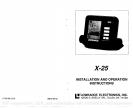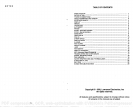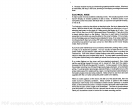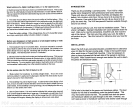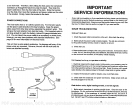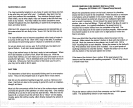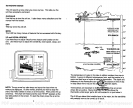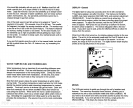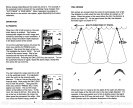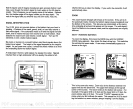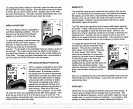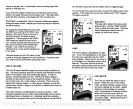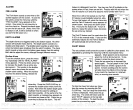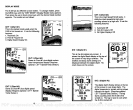
To
chanQe
from feet to meters or
vice-versa, press
the menu
key
until
SENSITIVITY
the FEEt/METER menu
appears.
Press
the down arrow
key
to switch
to
metric,
the
up
arrow to switch to feet.
Displays
show in feet when
the unit is first turned on. The menu
will clear
automatically
after a few
seconds or
press
the ON/CLEAR
key
to clear
the screen.
DISPLAY CONTRAST
The unit's
display
contrast is
adjustable
to
suit different
lighting
conditions. This will
help you
see the
screen from different
angles,
or at various
times of the
day.
To
adjust
the
contrast, press
the menu
key
until the DARK/LIGHT menu
appears.
To
decrease
it,
press
the down arrow
key.
Press the
up
arrow
key
to
increase the
contrast. The
bar
graph
in the
Dark/Light
menu box shows a
graph
of
the contrast. The screen
will also show the effects of the
change.
If
you
reach the maximum
or minimum
level,
a tone sounds
alerting you
to
the limits. The menu will clear
automatically
after a few
seconds or
you
can
press
the ON/CLEAR
key
to clear the screen.
ASP
(Advanced Signal
Processing)
ASP is a
program
embedded
in the X-25's
computer
that is
specifically
designed
to
eliminate noise. It
continually
monitors
the
signals
from the
receiver,
determines
which echoes are noise and
rejects
them.
This allows true
target
echoes to
display
on the screen with a
minimum of clutter.
This feature is
especially
useful since
it
typically
lets
you operate
the boat at
all
speeds
without
adjusting
the
sensitivity
or
other controls. When the
X-25 is first
turned on, ASP
is enabled.
To
turn
ASP
off,
press
the menu
key repeatedly
until the ASP menu
appears.
Now
press
the
up
arrow to turn it on or the down arrow to turn it off.
The
menu
will
clear
automatically
after a few seconds or
you
can
press
the
ON/CLEAR
key
to clear the screen.
The
sensitivity
menu lets
you
control
the unit's
ability
to
pick up
ech-
oes. A low
sensitivity
level excludes
much of the bottom
information,
fish
signals,
and other detail.
Nigh
sensitivity settings
lets
you
see
features,
but it can also clutter the screen
with noise and other un-
wanted
signals. Typically,
the best
sensitivity
level shows a
good,
solid bottom
signal
with
grayline.
The X-25
adjusts
the
sensitivity
level to
keep
a solid
bottom
signal
on
the
screen. It adds a little extra when it's
in
the
automatic mode. This
gives
it the
capability
to show fish and other detail. However,
situ-
ations occur
where it becomes
necessary
to increase or
decrease the
sensitivity
level.
Typically,
this occurs when
you
wish
to see more
detail,
so
you
need to increase the
sensitivity.
The
procedure
to
adjust
it is the same
whether the unit is in the automatic
or manual mode.
To
change
the
sensitivity
level,
first
press
the
menu
key
until the
sensitivity
menu
appears.
If the unit is in
automatic,
the
menu shows
"AUTO SENS."
Otherwise,
the menu shows "MAN SENS." Now
press
the
up
arrow
key
to increase the
sensitivity,
the down arrow to decrease it.
A vertical bar
graph
in the menu box
shows the
sensitivity
level. Echoes
scrolling
onto the
screen wilt also show the
effects
of the
sensitivity change.
If
you
reach the maximum
or minimum
sensitivity
level,
a tone sounds
alerting you
to the
limits.
After
you've adjusted
the unit to the desired
sensitivity
level,
press
the
ON/CLEAR
key
to
clear the
display.
If
you
wait a few
seconds,
it
will
automatically
clear.
GRAYLINE
GRAYLINE lets
you distinguish
between
strong
and weak echoes. It
"paints" gray
on
targets
that are
stronger
than a
preset
level. This
shows the difference between a hard or soft bottom,
large
fish versus
smaller
ones,
or rocks and brush on the bottom.
For
example,
a
soft,
muddy,
or
weedy
bottom returns a weaker
signal
which shows a
16
9
PDF compression, OCR, web-optimization with CVISION's PdfCompressor



